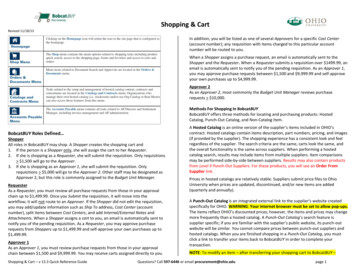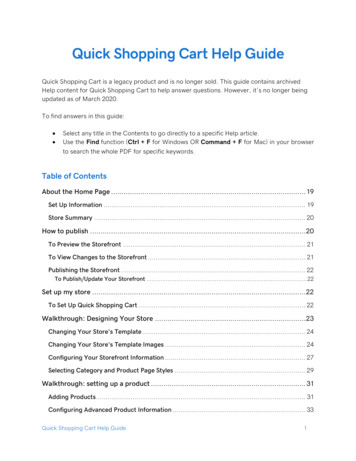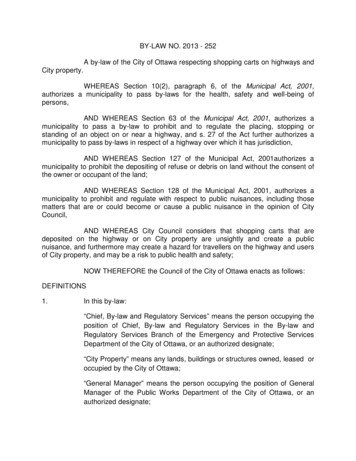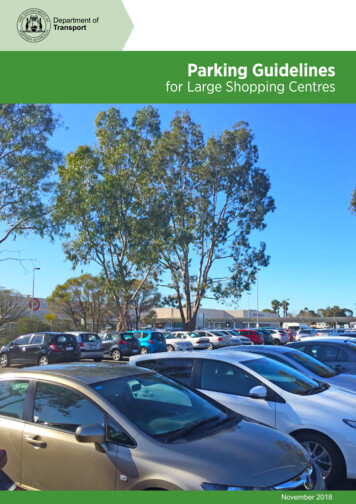
Transcription
ONLINE SHOPPINGGETTING STARTEDClass OverviewWhat You Will LearnPAGE 02ONLINE SHOPPING PROS AND CONSBenefits of Online ShoppingDisadvantages of Online ShoppingPAGE 03ONLINE SAFETYBefore You Shop OnlineStaying Safe OnlineProtecting Your IdentityMore InformationPAGE 05ONLINE STORESWhat Is an Online Store?Browsing for ItemsThe Shopping CartPaying for Your ItemsPAGE 07ONLINE AUCTIONSeBay and Other Auction SitesSearching for AuctionsBidding OnlinePAGE 12ONLINE CLASSIFIEDSCraigslist and Related SitesSearching for AdsBuying on CraigslistPAGE 16View our full schedule, handouts, and additional tutorials on our website:cws.web.unc.eduLast updated July 2015
2GETTING STARTEDClass OverviewThis is a class for beginning computer users. You should be familiar with the MicrosoftWindows operating system and using a browser to surf the Internet.Today we will be going over the basics of using the Internet to research, browse, andpurchase products. We’ll learn how to safely shop online, protect your personalinformation, find product reviews, and choose the appropriate type of shopping websitefor your needs. If you do not feel comfortable with any of the activities, it is completelyfine not to participate.Please let the instructor know if you have any questions or concerns before the class, oras we go along.You Will Learn How To:Weigh the pros and cons ofonline shoppingProtect your identity onlinePrepare to shop onlineFind online stores for avariety of productsCheck out safely from anonline storeBid on items on eBayBrowse for items onAmazon.comUnderstand how onlineauction sites workUse online classified sitesPay for items securely withcredit cardsPurchase items using thePayPal payment siteDifferentiate between thetypes of shopping sitesMaintain safe practiceswhile shopping onlineChoose the appropriate typeof shopping site for yourneedsUse the shopping cartSearch for auction itemsBuy and sell safely onCraigslistFind help if something goeswrong
3ONLINE SHOPPING PROS AND CONSAs with most online activities, there are definite tradeoffs in online shopping betweenconvenience, cost savings, choice, and privacy. Before you decide whether or not onlineshopping is for you, it is important to weigh the pros and cons of entering into the worldof e-commerce.Benefits of Online ShoppingConvenienceOne of the biggest benefits of online shopping is that you can buy almost anything youcould imagine without ever leaving your house. Online stores are open 24 hours a dayand are accessible from any location with an Internet connection.SelectionIn general, online stores are able to carry more selection than traditional brick-and-mortarstores. Because online stores don’t need to attractively display their items on shelves,they can keep a larger amount of inventory on hand. They also might only have smallamounts of each item, since they don’t need to display them, and can order more fromtheir supplier as needed.InformationOnline shops tend to provide more information about items for sale than you would get ina physical store (unless you asked a sales associate, and that can be hit-or-miss). Productdescriptions most often include a description from themanufacturer, another description from the vendor,specific technical and size details, reviews fromprofessional magazines and journals, and reviews frompeople who have bought the product. Online bookstores often will have excerpts of the books (usuallythe first chapter) for you to read. Having all thisinformation available when you are considering apurchase makes you a more informed consumerwithout having to perform extra research yourself.PriceBecause online stores don’t have to pay rent for a storefront in a nice part of town andtend to sell much larger quantities of goods, they can offer to sell products for a muchlower price. Discounts online can be substantial—up to 25-50 percent off the suggestedretail price. There are even some sites that only sell clearance items! However, buyingonline does take away from localbusiness, so that is a consideration tokeep in mind.
4Disadvantages of Online ShoppingHands-On InspectionOne thing that online stores can’t replace is the experience of actually seeing andtouching the item you are considering buying. For example, clothes shopping can be verytricky online, since you can’t try on the clothes before you buy. There may also be smalldetails that you decide you don’t like in a product that aren’t noticeable until you have itin your hand.ShippingSome major online retailers now offer free shipping for their products, but many requireyou to meet a minimum order cost to qualify or only offer this incentive at certain timesof year. In general, you should expect to pay an additional shipping cost on top of theprice of the items that you order. For larger items, like furniture, this can really add up!Additionally, if you decide that you don’t like a product, you will have to pack it back upand take it to the post office to returnit. Again, some retailers will offerfree returns, but some do require youto pay for return postage. In thatcase, even if you’ve decided againstkeeping an item, you’ve still had topay several dollars for the shipping!Wait TimeWaiting for your item to arrive is another downside of online shopping. One of the greatpleasures of shopping at a store is the instant gratification—you see something you like,you pay for it, and then you get to take it home and use it right away! In the case ofonline shopping, you may have to wait days or even weeks for the item to arrive at yourdoor. Especially if you are in a time crunch, then you may want to consider purchasingyour item at a local retailer.PrivacyWhen you shop online, you waive certain privacy rights to the online retailer. Onlinestores can track your purchases over time to give you more suggestions of things youmight like to buy, send you e-mails with sale information, and, occasionally, sell yourcontact information to other companies. These days, many brick-and-mortar stores do thesame thing, tracking your information through your credit card (Target is a notableexample). However, it is much trickier for traditional stores to do this, as you maysometimes pay in cash or refuse to provide your e-mail address at checkout. In contrast,by purchasing something in an online store, you sign away certain privacy rights—this iswhy it is always a good idea to read the Terms of Service.
5ONLINE SAFETYThe Internet is a great resource and can be a powerful tool for finding information,shopping, and communicating. But, just like everything else in life, you need to becareful using it. There are some bad people who will try to steal your information online,but if you take the proper precautions, identity theft will be unlikely to happen to you.Before You Shop Online Contact your bank and find out about their policies regarding identity theft. It isalso important to know these policies about your credit cards. Will you be heldresponsible for purchases made with your information, should it be stolen?Consider installing anti-virus software on your computer. Antivirus software forone computer is typically less than 50, depending on the brand and protectionperiod (i.e., some antivirus software is only good for a year). The most popularbrands of anti-virus software are Symantec/Norton and McAfee. You can buyanti-virus software anywhere computers are sold. Talk with a sales associate at acomputer store in order to determine which program best suits your needs.After you install anti-virus software on your computer, you will need to update itfrequently (most programs will do this automatically). Just like real viruses,computer viruses can change quickly over time. Consider an anti-virus update likegetting your annual flu shot, except needed more often.Be aware of the variety of scams that appear on the Internet. As a general rule, ifyou get an offer from an unknown e-mail address (or even an e-mail forwarded onfrom a friend!) that sounds too good to be true, it most likely is.Staying Safe Online Shop on secure websites. When you log in with your account information, a securewebsite’s address will begin with “https://” instead of “http://”. This stands for asecure HTTP connection. If you are using Internet Explorer, a padlock should appearin the top right-hand corner of the address bar in your internet browser window.Many sites will also have some form of a verification symbol to show that companycomplies with the highest form of encryption and security. Always read a website’s privacy policy before providing any information. Ifsomething doesn’t sound right, don’t give them your information! You wouldn’thand your credit card to just anyone on the street, so don’t do it online. Makingwebsites is easier than you think, and sometimes crooks can create verylegitimate-seeming websites.Smaller websites often use PayPal, a middleman company that exclusivelyhandles online purchases. Using PayPal is generally considered safe, but alwaysread the privacy policy and beware of imposters!Legitimate websites will never ask for your credit card number or other personalinformation by e-mail, so never trust e-mails that request this information, even ifit appears that the e-mail came from PayPal or Amazon.com. Also, don’t click onany links in the e-mail if it requests this sort of information—it’s probably a scam.
6 Deal with businesses that are accredited by the Better BusinessBureau. Businesses that are accredited by the BBB arecommitted to solving consumer complaints. These businessesassure a method of recourse if something goes wrong duringyour transaction.If you’re not sure, stick to the websites of large companiesyou’re already familiar with from their physical stores—they’remore likely to have a secure website. For example, youprobably recognize and would trust Target.com or Bestbuy.com. Other popularonline shopping sites include Amazon.com (books, music, etc.), Zappos.com(shoes), and Etsy.com (DIY apparel).Protecting Your IdentityThere are several key behaviors that can help ensure that your identity is protected online: If you have anti-virus software on your computer, be sure to periodically updateit. This will keep newer viruses from infecting your computer.Do not open .exe files sent to you via e-mail if you do not trust the source. .Exefiles can install spy software or other viruses on your computer that can bedifficult to remove.Anti-virus software will sometimes remove links from e-mail messages if theyhave been flagged as malware (malicious software). If you occasionally get emails missing links, your anti-virus softwareis working!Do not forward chain e-mails. Chain e-mailsoften prey on sympathy, contain jokes, orinclude vague threats (e.g., “Someone will dieof cancer if you do not forward this e-mail”).Computer programmers can collect e-mailaddresses and information from these e-mails,so it is best to ignore them.Use a secure browser when making purchasesExample of a Chain E-mailonline, and avoid storing passwords and personalinformation on your computer.More InformationFor more information about how to stay safe online, check out these websites:www.safeshopping.org – An informative website maintained by the American BarAssociation that tips about how to stay safe while shopping online.www.onguardonline.gov– The Federal Trade Commission provides excellent informationabout online safety and preventing identity theft.
7ONLINE STORESWhat Is an Online Store?You can think of an online store like a combination of a traditional brick-and-mortarstore, warehouse, and consumer magazine. You are able to browse and search for items,as you would in a regular store; there is a wider range of products, sizes, and colors ofproducts, as you would find in a warehouse; and most online stores contain reviews ofproducts by people who have already purchased and tried out the product.Online stores have been around since 1994, right after the birth of the Internet. One of themost famous online-only retailers, Amazon.com, launched in 1995. Over 142 billionwas spent on online retail sales in the United States in 2010. Clothing is the mostcommonly purchased item on the Internet, followed by jewelry.Most traditional stores also have an online version of their store (For example, Walmartalso sells products through www.walmart.com). However, you should be aware of someof the very well-known and trusted online-only retailers.Amazon.com: Amazon started out as an online book retailer, but todaythe site sells everything from books and DVDs to kitchen appliancesand groceries. Amazon is the creator and sole seller of the KindleeBook reader. It is the world’s largest online retailer.Zappos.com: When Zappos started in 1999, it only sold shoes, butquickly grew, in part because of its free shipping both ways (i.e., freereturns up to 365 days later) policy. Today, Zappos sells clothing andshoes, and has become famous for their customer service.Etsy.com: Etsy is a marketplace for handmade, DIY, and vintage items.You can find everything from handmade clothing, photographs, and bathproducts to craft supplies and antique housewares.eBay: The most well-known auction site on the Internet, eBay allows youto bid on anything from playing cards to cars. eBay now also offers a“Buy-It-Now” feature, making it much more like a traditional retail site.eBay was the first site to use PayPal as a means of payment; we will talk about thisservice and its pros and cons later in this handout.Groupon: If you love a bargain, Groupon offers daily deals that youcan buy to local businesses. They also sell discounted limited-lengthsale items, like electronics or other luxury items. Deals are deliveredto your e-mail inbox daily, so that you don’t miss out on any of the latest deals!
8Browsing for ItemsJust like you would in a regular store, you can either look for a particular item or browsearound in an online store.If you already know what item you are looking for, you can go ahead and search for thatparticular item. On most shopping websites, a search tool will be located at the top of thescreen. Type in the item name and press “Go,” “Search,” or a similar word. The examplebelow comes from Amazon.com.If you do not have a specific product in mind, you may either browse bydepartment, usually located on the left-hand side of the screen, or searchfor a very broad category of item, like “toys.” If you know you are in themarket for a new TV, for example, you might search for “television” inthe search box, which would then show you all the different types ofTVs that Amazon carries. You could also browse in the “Electronics &Computers” department. Most departments also have subcategorieswhen you click on them; for example, the “Electronics & Computers”department includes “TV & Video,” “Laptops, Tablets, & Netbooks,”“Appliances,” and more.Often, you might get anoverwhelming numberof results when you search, so you cannarrow down your results by smallercategories (for example, HDTVs, 3DTVs, specific brands of TVs). Thesesuggested refinements and links mightbe at the top or left-side of the screen,depending on the website.To find out more information about aproduct, you may either click on thepicture of the item, or the name of theitem. To return to the list of items,simply use the back button on your browser.You can always change the department where you are browsing or refine your search atany point in the process. Simply enter a new or more specific word in the search box atthe top of the screen and click “Search.” You can always get back to your previous searchby using the back button on your browser. Likewise, you can simply click on a newdepartment to change where you are browsing.
9The Shopping CartWhen you find an item that you like and you areready to buy it (or at least seriously considerbuying it—just like putting an expensive groceryitem in your cart, you can always return it to theshelf before you check out), you simply click onthe “Add to Cart” or “Add to Shopping Cart” button at the top of the product page. The“Shopping Cart” is also sometimes called the “Shopping Bag.” You can also usuallyspecify how many of the item you would like purchase at this point.Items will automatically go into your cart after you click the “Add” button; you can viewyour cart at any time. There is usually a little picture of a cart in the top right corner ofany shopping page—click on this to view what you have placed in your cart.When you click on the shopping cart icon, you will be able to review all of the items thatyou have placed in there—you are not obligated to purchase anything simply becauseyou have put it in your cart. You are only financially liable for items remaining in yourcart after you click on the “Check Out” or “Pay Now” buttons and enter your paymentinformation.From the shopping cart page, you can change the number of a particular item you wouldlike to purchase, “delete” or take an item out of your cart, review the specifics of theitems in your cart by clicking on the item name or picture, and see a running subtotal ofthe cost of your items.
10Paying for Your ItemsWhen you have decided on what you would like to purchase, you can complete yourtransaction by clicking on the “Checkout,” “Proceed to Checkout,” or a similarly namedbutton in the shopping cart.Many online shopping websites require you to create an account before you can checkout—generally, all you will need to do is enter your e-mail address and create apassword. These businesses ask for this so that they can send you advertisements anddeals to your e-mail inbox, as well as keep a record of all of your purchases—the cost ofthe convenience of online shopping!For most shopping websites, youwill need to input, at a minimum,your name and e-mail address, aswell as create a password, in orderto check-out with your items. If youthink that you might forget yourusername or password, then enteringyour mobile phone is probably agood idea. It also allows you to gettext messages about item deliveriesto your phone, which may behelpful or annoying.In order to receive your items, you will need toenter an address for where you would like theproducts to be shipped. This may or may not bethe same as your billing address. You may alsochoose to ship your items to other people.Depending on the website that you are using, thisstep might look slightly different, and ask forslightly different information.
11You generally have several options of payment methods when purchasing items online.The most common way to pay online is with a credit card; you almost never want to payfor items online with cash or cash-like methods(e.g., debit cards, money orders, personal checks).Credit cards offer some additional protections fromfraud, including zero-liability policies (you are notheld responsible for purchases made with yourstolen card) and credit protector services that alertyou to fishy activity. Importantly, credit cards arenot directly linked to your bank account, so nomoney will be withdrawn from your account untilyou pay your monthly bill.Some people prefer to pay for their online purchases through online payment services,like Google Checkout and PayPal. These services act like middlemen in the onlineshopping world—you give your credit card information to one of these services, thenthey will disguise your information to the merchant. This way, your credit cardinformation is only shared with one company. There is no cost for you to pay with theseservices, but there is a small charge for vendors. Many larger companies and companiesthat appreciate that customers would feel more comfortable with these services offerthem, but not all companies do. All eBay purchases, for example, are conducted viaPayPal (more on this in a moment).PayPal and other payment websites will never ask for your credit card number or otherpersonal information by e-mail, so never trust e-mails that request this information, evenif it appears the e-mail looks like it came from PayPal or Google Checkout. Don’t clickany of the links in the e-mail if it requests this sort of information—it’s probably a scam.Many shopping websites now include anadditional security measure called a“captcha.” This is a photograph of a wordthat might look a little bit blurry or hardto read and is meant to prove that you area human and not a robot. These can betricky to decipher and, depending on thewebsite, sometimes you can have thewords read out loud to you or get morethan one chance to enter it correctly.Examples of Captchas
12ONLINE AUCTIONSRetail sites are not your only option when shopping online. You can also bid for yourdream items (vintage Elvis toaster, anyone?) in online auctions.eBay and Other Auction SitesThe most popular online auction site is eBay, though there are many other sites that offersimilar services, including QuiBids, uBid, and eBid. These sites all offer services that aresimilar to a silent auction, meaning that anonymous bids are submitted through the sitefor a specific item and the item goes to the highest bidder.eBay was founded in 1995 and the first item sold on the site was a broken laser pointer.Since then, eBay has expanded internationally and has annual revenues of almost 7.7billion. It is considered the most reputable online auction site and is frequently referencedin pop culture.Each item on these online auction sites is listed by an individual seller—eBay and theother companies do not list these items and you will be dealing with an individual person.eBay does offer buyer protections; for example, if you never receive an item that youwon in an auction, eBay will refund your money through PayPal. This makes buyingitems through these sites less risky for you.Searching for AuctionseBay allows you to search for an auction by category or by item keyword. From the eBayhome page, you have options to browse by category or enter a term in the search box atthe top of the screen:Each category includes further subdivisions; for example, Home, Outdoors & Décor
13includes Home & Garden, Hobbies & Toys, Baby, and more. From there, you will findeven further subdivisions of categories.If you choose to use the search box to look for items instead, besure to use as specific keywords as possible. If you are lookingfor a Batman lunchbox, be sure to use both the words “Batman”and “lunchbox”—this way, you won’t get everything to do withBatman or every style of lunchbox. After you run your initialsearch, you can also use the options on the left side of the screento specify cost, condition, brand, size, or color.You may also perform an advanced search, which is located rightnext to the search box. By clicking on this link, you will be takento a page that allows you to search by other options, such aslocation, shipping options, currency accepted, and more.Some auctions have a “Buy It Now” option, which means that the seller has set a pricethat they are willing to accept to just let you buy the item. This is only available beforeanyone else has bid on the item, and is usually a bit (or a lot) more expensive than thestarting bid. However, it does take away the stress of a bidding war. You can also chooseto search by items that have this option. Some sellers will also accept the best offer.Your search results will be sorted by the “best match” by default, but you can choose tohave them listed by time remaining in auction, price, or distance, depending on yourpreference.
14Bidding OnlineJust as you are required to create an account to buy things on retail sites, you are alsorequired to create an account on eBay to buy or sell items. From every eBay page, thereare links to both “Sign In” and “Register”:This allows for more security than Craigslist.org and allows you to keep track of yoursearches, leave feedback, and use other services. By requiring sellers and buyers toidentify themselves in some way, eBay is then able to monitor behaviors and keepdisreputable people at bay.By entering your personalinformation, such as yourname and address, this willtell sellers where to ship theitems that you have won. Itwill also allow for accuratecalculation of shipping costs.By entering your phonenumber, you can recoveryour account password if youforget it later.You will also need to create auser ID and password. Theuser ID will be displayed toother bidders and the sellerinstead of your name. Youmust also pick a secretquestion, in case you forgetyour password.Once you’ve completed all ofthese steps, click “Submit”and eBay will send aconfirmation to your e-mailaddress and you can startbidding!
15Once you’ve found an item that you are interested on bidding on, be sure to read the fineprint—how much shipping will cost, if there is a reserve (a price below which the sellerwill not accept a purchase), and, importantly, the seller’s reputation. Each buyer andseller on eBay has a feedback score, which lets you know how many transactions theperson has been involved with and how other people have rated them. It is always a goodidea to read what other people have to say about a seller before choosing to do businesswith them.Feedback ScoreWhen you are ready to bid on an item, click on the Place Bidbutton below the current bid price:A window will then pop to prompt you to enter your maximum bid (which does notinclude shipping). You have until the end of the auction to enter your bid. Your bid willthen increase every time someone else bids until your maximum is reached or exceeded:In general, once you have made a bid, you cannot retract it, so be sure that you arewilling to pay your maximum price for an item before you place a bid.Once you win an auction, the seller’s e-mail will be sent to you via e-mail. eBay will alsolet you know the next steps for how to complete your transaction. You can get in contactwith sellers at any time to ask questions about items by clicking on their username.Sellers cannot access your contact information, however, unless you bid on or win one oftheir auctions.
16ONLINE CLASSIFIEDSIf online retail sites are like department stores and eBay is like an auction house, thenCraigslist and other online classified sites are like gigantic yard sales.Craigslist and Related SitesTo a large extent, Craigslist and similar sites have replaced newspaper classifieds as away for people to advertise and sell their used household goods, cars, etc., or rent homesand apartments.Craigslist began in 1995 as an e-mail list among friends in SanFrancisco, to keep them up-to-date on local events. In 1996,Craigslist moved online and started to include postings aboutbuying and selling, not just event notices. Today, the site covers over 700 cities,metropolitan areas, and regions in 70 countries. There are over 20 billion page views permonth on the site, with 49.4 million unique U.S. visitors monthly. Over 80 million newads are placed on the site every month. It is available in 12 languages, including Danish,Dutch, English, Filipino, French, German, Italian, Norwegian, Portuguese, Spanish,Swedish, and Turkish.While Craigslist is the largest and most frequently used online classified site, there areother sites that perform similar functions, including Oodle (formerly FacebookMarketplace and powering Walmart’s Marketplace), Yahoo Classifieds, and eBayClassifieds (formerly Kijiji).Before you decide to use one of these online classifieds sites, there are a few things tokeep in mind:o You are responsible for your postings and interactions with members of theonline classifieds community—these sites bear no responsibility.o These sites provide a way for you to get in touch with sellers and buyers, butare not involved in any transactions. If you are scammed or cheated out ofyour money, your only recourse is through the Federal Trade Commission.o These sites are relatively anonymous and you might not always know whoyou are dealing with.You should also follow some additional safety measures when engaging in this type ofbuying and selling:o Always meet with buyers and sellers in public places. Do not invite thepeople you connect with on these sites into your home.o Before you go meet a buyer or seller, let friends and family know where
17you are going.o Take a cell phone with you when you go to meet a seller or a buyer.o If you ever feel like something is weird or just not right, trust yourinstincts.Searching for AdsTo begin, go to www.craigslist.org. In most cases, it will automatically detect yourlocation and show you listings that are relevant to your area:As you can see, there are many different categories of listings for you to browse through,everything from personals to job listings, furniture sales to apartment rentals. When youclick on a category, listings will be displayed from the most recent to the oldest.
18Search results will include a brief title description and location of the seller, as well as theprice and information on whether or not there is a picture included.You can also search for specific items or listings by using thesearch tool on the left-hand side of the home page.From here, you do have to choose the general category thatyour search would be housed in: For Sale, Personals,Housing, etc.At the top of any page of results, you can also narrow yoursearch by price, whether or not a picture is included, and ifyou want to search only the title of the listings or the entirepost for your keyword (entire post will give you more results,but not all will be relevant).Click on the blue listing title in order to see the full description of the item.If you feel that a listing is inappropriate in some way, you may flag the listing and reportit to the Craigslist moderators. You can do this if the listing is in the wrong category, ifthe advertisement is spam, or if it is advertising content that is prohibited (e.g.,pornographic content).
19Buying on CraigslistWhen you find an item that you are interested in purchasing, you will then need tocontact the sell
more likely to have a secure website. For example, you probably recognize and would trust Target.com or Bestbuy.com. Other popular online shopping sites include Amazon.com (books, music, etc.), Zappos.com (sho











